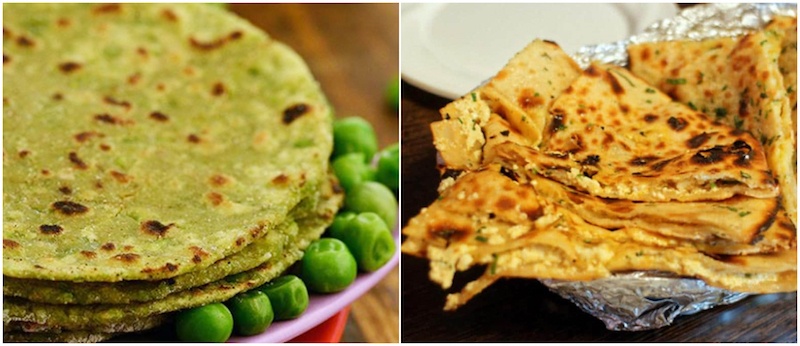Idli, dosa, poha, paratha are all staple components of traditional Indian breakfasts and preferred any day over a bowl of breakfast cereals by the aam junta. Parathas are relatively easy to prepare with only kneading the dough, filling it with stuffing (optional), and rolling it out into flatbreads required. Not to mention, paratha is an incredibly versatile dish that can be enjoyed in various ways and can be stuffed with a variety of fillings like aloo, paneer, onion, gobi, palak, and mooli. Its versatility makes it an ideal breakfast, lunch, dinner, and even a snack option. In fact, they find a special place on the menu of street side stalls, local eateries, and even high-end restaurants. When made from 100% whole wheat, millet flours like bajra, jowar, etc., parathas provide complex carbs and minerals. Also, the fillings in stuffed parathas often include vegetables, which add essential vitamins, minerals, and fiber to the diet. Overall, the simplicity of cooking, the taste, versatility has made paratha a staple food in Indian households. However, individuals who are trying to lose weight feel they need to eliminate parathas from their diet to see results, but that’s not the case, in fact, here’s how you can eat paratha without gaining weight.


1. Pick A Healthy Flour To Knead The Dough:
Avoid maida or all-purpose flour to prepare the paratha flour because the refining process reduces the fiber content in all-purpose flour, making it less beneficial for overall health. Wheat naturally contains vitamins, minerals, and antioxidants, but these are concentrated in the bran and germ, which are removed during the milling process to make all-purpose flour. As a result, all-purpose flour has lower levels of nutrients like B vitamins, vitamin E, iron, zinc, and magnesium. Maida also has a high glycemic index, which means it raises blood sugar levels rapidly after consumption. Foods with a high glycemic index can lead to spikes and crashes in blood sugar levels, potentially contributing to increased risk of type 2 diabetes, weight gain, and other health issues. Make your parathas with 100% wheat flour and millet flours like bajra, jowar, to avoid weight gain. Also read: “10 Healthiest Flours For Weight Loss.”
2. Choose Protein-Rich Stuffing:
Paneer, green peas, sattu, sprouted moong dal, broccoli, and even potato filling are no doubt healthy; however, paneer, green peas, sattu, sprouted moong dal have a higher protein content compared to others. When trying to lose weight, amping up your protein content helps a great deal and choosing a protein-rich filling would help meet the protein requirement.

3. Use Less Oil, Choose Healthy Fats:
Cooking oils are a highly concentrated source of calories, with refined sunflower oil (commonly used in Indian cooking) containing approximately 120 calories per tablespoon and mustard oil may have up to 124 calories. Other most commonly used cooking oils (vegetable, olive, coconut, canola) have been found to have calories in the same range with 14 gm of fat per tbsp. By eliminating or reducing oil consumption, individuals can significantly reduce their caloric intake, which can support their weight loss efforts. Use minimal oil or choose those with healthy fats such as olive oil or ghee to make parathas.
4. Pick Healthy Side Dishes:
Healthy side dishes add flavor and variety to the meal. Side dishes provide an opportunity to incorporate a variety of nutrient-dense foods. They complement the main dish and offer contrasting textures, colors, and tastes. For example, homemade pickles are a good source of probiotics, yogurt also is a good source of probiotics, calcium, etc. Also, raita, which is a yogurt-based condiment can be made with healthy additions such as cucumber, onion, mint.
5. Include a Flavourful Salad:
Combining paratha with a salad can create a well-rounded and nutritious meal. You can prepare a simple salad with cucumber, tomato, onion, carrot, etc., and squeeze lemon to get a tangy taste. Another option is to use paratha as a base and then top it with a salad. Cook the paratha as usual and then layer it with a generous serving of fresh salad ingredients such as lettuce, carrot, cucumber, even boiled or roasted chickpeas. Roll or fold the paratha to enjoy a delicious and nutritious combination of flavors.
6. Combine Parathas With Nutritious Curries:
Paneer-based curries, like paneer tikka masala or palak paneer, are rich and creamy options that go perfectly with paratha. Or enjoy the paratha with a bowl of dal for a complete and satisfying meal. A mixed vegetable curry would also add a lot of flavour and nutrients to the meal.
7. Practice Portion Control:
Most importantly, practicing portion control is essential even with the healthiest of foods to achieve weight loss, as it helps to manage calorie intake. By controlling portion sizes, you can reduce overall calorie consumption and help with the inclusion of nutrient-dense foods, forming healthier eating habits. Combining portion control with exercise would amplify your weight loss efforts. Even if it’s paratha, poha, or oats, practicing portion control is necessary.
Summing up, parathas can be a part of a balanced diet, and can be enjoyed as part of a well-rounded meal, incorporating healthy fillings and side dishes. Most importantly, if you are struggling to lose weight and confused about what to eat and what not to eat, subscribe to the Rati Beauty diet plans to lose weight successfully.
10 Healthiest Flours For Weight Loss
10 Tips to Portion Control Food for Weight Loss
Stay connected with us on social media platform for instant update click here to join our Twitter, & Facebook
We are now on Telegram. Click here to join our channel (@TechiUpdate) and stay updated with the latest Technology headlines.
For all the latest Health & Fitness News Click Here
